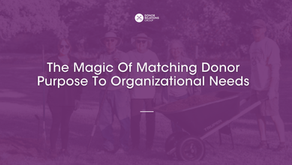Unspent Funds Are Breaking Donor Trust—Here’s How to Stop It
- Lynne Wester

- Jun 17
- 4 min read

Let’s talk about the unspoken elephant in the room… or rather, in the ledger. Unspent donor funds.
It’s the kind of phrase that makes both advancement leadership and frontline teams squirm (Which might be why we avoid talking about it). But let’s be honest: when a donor gives generously, there’s an expectation that their gift will be put to work—not parked in a bank account collecting dust (or interest).
And yet, this issue persists across institutions of all shapes and sizes.
What the Data Says
In 2024, DRG surveyed organizations across the nonprofit and education sectors. The findings were eye-opening:
52% of higher ed institutions reported that unspent donor funds accounted for more than half of their most recent fundraising totals.
Nearly 30% of all respondents held $1 million – $9.99 million in unspent funds; 17% had $10 million – $100 million, and 5% reported over $100 million sitting idle.
Only 4% felt “very comfortable” with their current unspent fund levels, while more than 80% expressed some level of discomfort.
Just pause for a second. Imagine what your organization could do with an extra $1 million, much less $100 million.
Why Funds Go Unspent
There isn’t one culprit—there are several. The most common include:
Administrative confusion – unclear or outdated fund criteria and overly complex gift agreements.
Operational silos – finance, development, and program teams aren’t aligned on spending.
Fear-based hoarding – holding onto funds “just in case” instead of activating them for impact.
Lack of planning – no roadmap for how or when funds should be used.
Lack of awareness – in some cases, teams don’t even know the funds exist.
But regardless of the reason, one thing is crystal clear: Donors don’t give to create savings accounts. They give to make a difference.
And here’s the hard truth: Unspent funds are more than a missed opportunity—they’re a breach of trust.
Why It Matters
According to the Donor Bill of Rights, three of the ten rights relate directly to how we spend and report on gifts. If we don’t activate donor dollars, we’re not honoring our side of the partnership.
When we delay spending or fail to communicate why, we send the message that we didn’t need the donor’s help after all. We know that’s not the case. But perception is reality, and in the donor experience, it’s everything.
Trust is fragile. Unspent funds chip away at the belief that their gift matters, and erosion can quietly but powerfully undermine retention.
Which leads us to a risk we can’t afford to ignore.
Unspent funds aren’t just a stewardship issue. They can become a reputational one, too.
If donors—or worse, the media—discover large sums sitting untouched while scholarships go unawarded or community programs remain underfunded, it could lead to a PR crisis that no amount of spin can fix.
In today’s environment, where public trust in institutions is already delicate, we don’t need headlines like:
“Nonprofit raises $50 million… and forgets to spend $25 million of it.”
That’s not the story we want to be told. And thankfully, we have the power to write a better one. Because here’s the flip side: this is a golden opportunity. With our constant budget conversations and creative work, this is the perfect time to check under the proverbial seat cushions. Some of the answers we’re looking for may already be sitting on our balance sheets.
Ask yourself:
Are we fully leveraging the resources already entrusted to us?
Could we meet urgent needs by reactivating dormant dollars?
Putting those funds to work now could protect programs, cover staffing gaps, or fuel new initiatives without needing to ask for another dollar. That’s not just responsible; it’s strategic leadership.
What You Can Do
Ready to move from awareness to action? Start here:
1. Review Your Funds
Identify restricted or designated funds that haven’t been touched in 12+ months.
Focus on both the percentage unspent and the total dollar value.
2. Create Spending Thresholds
Develop clear policies for when funds must be reviewed or utilized.
Partner with finance to ensure these thresholds are part of standard practice, not an afterthought.
3. Establish Cross-Functional Task Forces
This isn’t a solo mission. Create task forces that include stakeholders from development, finance, and programs.
Use this group to spot problem funds and patterns, like scholarships with zero applicants or overly niche designations.
4. Fix Broken Agreements
Some funds can’t be spent because the terms are outdated or impossible.
Use tools like cy pres or donor amendments to bring them back to life and into mission alignment.
5. Reform Budget Modeling
Advocate for budget models that prioritize philanthropic investment, not just operational surplus.
Align planning cycles so donor dollars are integrated, not left on the sidelines.
6. Empower Your Frontline Fundraisers
Start at the source. Educating your team on how the gift is spent is just as important as how it’s secured.
Work with your fundraisers to set shared expectations during the gift conversation. This will allow your fundraisers and eventually, your donors, to have a realistic view of how our organizations work and how their gift will further your mission.
Final Thoughts
This isn’t just about leaving money on the table. It’s about fulfilling your mission. It’s about telling your donors:
We see you, we hear you, and we’re putting your generosity to work.
We can’t afford to let trust erode while dollars sit idle. So review your funds, take action, and—above all—communicate.
Because unspent doesn’t just mean unused—it can also mean unappreciated.
By Liz Menne
Need Help With Unspent Funds? Learn more about DRG’s Fund Audit Services or reach out to start the conversation today.





